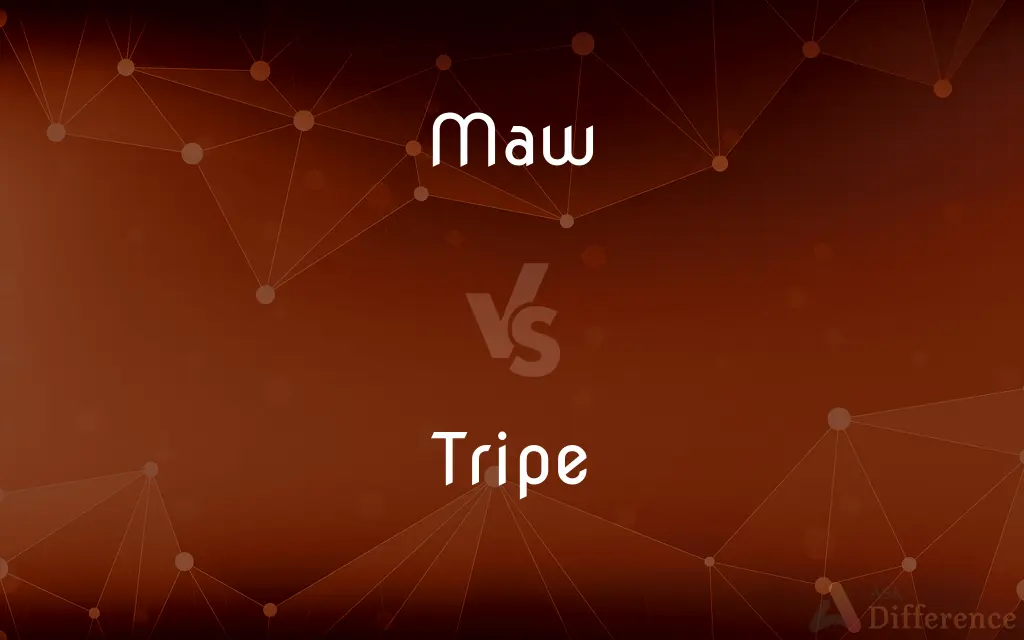Maw vs. Tripe — What's the Difference?
Edited by Tayyaba Rehman — By Fiza Rafique — Updated on April 2, 2024
Maw refers to the stomach of an animal, often used broadly, while tripe specifically denotes the stomach lining of ruminants, used as food.

Difference Between Maw and Tripe
Table of Contents
ADVERTISEMENT
Key Differences
Maw traditionally describes the stomach or esophagus of an animal, particularly in the context of voracity or capacity for consumption. It's a term with broad usage, sometimes extending to signify any part of the stomach or even used metaphorically to express a voracious appetite. Tripe, on the other hand, specifically refers to the edible lining from the stomachs of various farm animals, most commonly cows. It is considered a delicacy in many cuisines worldwide, known for its unique texture and flavor.
While "maw" may appear in various contexts, from literature to describing the ferocity of animals, its use in culinary terms is less specific than tripe. Tripe is strictly a culinary term, associated with specific dishes and preparation methods across different cultures, such as in stews, soups, or even fried dishes. The preparation of tripe is often elaborate, involving cleaning, bleaching, and cooking for extended periods to achieve the desired tenderness and flavor.
The nutritional content of maw and tripe can vary, but tripe is particularly noted for being low in fat and high in protein, making it a favored ingredient in health-conscious diets. Moreover, tripe is rich in vitamins and minerals, contributing to its appeal beyond its culinary uses. Maw, as a more general term, doesn't have a standardized nutritional profile, since it could refer to different parts of an animal's stomach.
In terms of cultural significance, tripe enjoys a celebrated status in many culinary traditions around the world. From Europe to Asia and Africa, tripe is integral to various traditional dishes, appreciated for its ability to absorb flavors and its distinctive texture. Maw, while used in some regional cuisines, doesn't have the same widespread culinary application or recognition as tripe, often being overshadowed by more specific terms like "tripe" when referring to edible stomach parts.
Both terms, maw and tripe, offer insight into the relationship between food culture and language. While maw presents a broader, sometimes metaphorical concept of consumption and capacity, tripe represents a specific, valued food source with deep cultural roots. The distinction between the two highlights the nuances in how we relate to and utilize animal parts in cooking and language.
ADVERTISEMENT
Comparison Chart
Definition
The stomach or esophagus of an animal.
The edible stomach lining of ruminants.
Culinary Use
Broadly refers to animal stomachs, less specific in culinary context.
Specifically used as food, especially in traditional dishes.
Preparation
Varied, not specifically culinary.
Involves cleaning, bleaching, and lengthy cooking.
Nutritional Value
Varies; not standardized.
Low in fat, high in protein, vitamins, and minerals.
Cultural Significance
Less specifically celebrated in cuisine.
Integral to many traditional dishes worldwide.
Compare with Definitions
Maw
Refers to the stomach or esophagus of an animal, often used broadly.
The shark's maw can hold a vast amount of food.
Tripe
Specifically the stomach lining of ruminants, used in food.
Tripe is a key ingredient in the traditional Mexican dish, menudo.
Maw
When used in cooking, it lacks the specificity of terms like tripe.
Maw soup in some cultures may not specify which part of the stomach is used.
Tripe
Known for being low in fat and high in protein.
Tripe provides essential nutrients, making it a beneficial component of a balanced diet.
Maw
Can be used metaphorically to describe insatiable appetites.
The maw of consumerism is endless.
Tripe
Celebrated in global cuisines for its unique texture and flavor.
Italian cuisine prizes tripe in dishes like trippa alla Romana.
Maw
Its cultural significance varies, not always associated with food.
In folklore, the maw represents the gateway to the underworld.
Tripe
Considered a delicacy in many cuisines, prepared in various ways.
In France, tripe is stewed with onions, carrots, and celery in calvados.
Maw
Appears in literature to describe voracity or greed.
The novel described the monster's maw as an abyss of darkness.
Tripe
Integral to traditional dishes across the world.
Tripe soup is a comforting dish in Eastern European countries.
Maw
The mouth, stomach, jaws, or gullet of a voracious animal, especially a carnivore.
Tripe
Tripe is a type of edible lining from the stomachs of various farm animals. Most tripe is from cattle, pigs and sheep.
Maw
The opening into something felt to be insatiable
"I saw the opening maw of hell" (Herman Melville).
Tripe
The rubbery lining of the stomach of cattle or other ruminants, used as food.
Maw
(archaic) The stomach, especially of an animal.
Tripe
(Informal) Something of no value; rubbish.
Maw
The upper digestive tract (where food enters the body), especially the mouth and jaws of a fearsome and ravenous creature.
Tripe
The lining of the large stomach of ruminating animals, when prepared for food.
Maw
The mouth.
Shut your maw!
Tripe
The entrails; hence, humorously or in contempt, the belly.
Maw
Any large, insatiable or perilous opening.
Tripe
Something foolish or valueless, especially written works and popular entertainment (movies, television).
Maw
Appetite; inclination.
Tripe
An edible lichen, especially rock tripe.
Maw
Mother.
Tripe
(pejorative) That (what has just been said) is untrue.
Maw
A gull.
Tripe
The large stomach of ruminating animals, when prepared for food.
How say you to a fat tripe finely broiled ?
Maw
A gull.
Tripe
The entrails; hence, humorously or in contempt, the belly; - generally used in the plural.
Maw
A stomach; the receptacle into which food is taken by swallowing; in birds, the craw; - now used only of the lower animals, exept humorously or in contempt.
Bellies and maws of living creatures.
Tripe
Lining of the stomach of a ruminant (especially a bovine) used as food
Maw
Appetite; inclination.
Unless you had more maw to do me good.
Tripe
Nonsensical talk or writing
Maw
An old game at cards.
Maw
Informal terms for the mouth
Common Curiosities
Can maw and tripe be used interchangeably in cooking?
Not precisely; maw is a broader term, while tripe specifically refers to the edible stomach lining of ruminants and is associated with specific culinary uses.
What is maw used for?
Maw is generally used to refer to the stomach or esophagus of an animal, with varied applications from literature to certain regional cuisines.
How is tripe prepared?
Tripe is typically cleaned, sometimes bleached, and then cooked for several hours to achieve tenderness and flavor, often used in soups, stews, and other dishes.
Is tripe considered an offal?
Yes, tripe is considered offal, which refers to the internal organs and entrails of a butchered animal. Offal includes various organs, including the stomach lining (tripe).
How do you clean tripe before cooking?
Cleaning tripe involves rinsing it under cold water, trimming away any fat or unwanted parts, and sometimes blanching it in boiling water to remove impurities.
What nutritional benefits does tripe offer?
Tripe is rich in protein, low in carbohydrates, contains vitamins such as B12, and is a good source of minerals like zinc and iron, which contribute to a healthy diet.
Is tripe healthy to eat?
Yes, tripe is low in fat and high in protein, vitamins, and minerals, making it a nutritious addition to the diet.
Why is tripe popular in traditional cuisines?
Tripe is popular for its unique texture, ability to absorb flavors, and nutritional value, making it a staple in various traditional dishes around the world.
Is there a difference between maw and stomach?
Maw is a term that can refer to the stomach but is sometimes used more broadly to include other parts of the digestive or feeding apparatus, especially in literary or colloquial contexts.
How does the flavor of tripe compare to other meats?
Tripe has a mild flavor with a unique, chewy texture. It absorbs the flavors of the ingredients it's cooked with, making it versatile in many recipes.
Are there different types of tripe?
Yes, there are different types of tripe, depending on which part of the stomach it comes from. The most common types are blanket tripe, honeycomb tripe, and book tripe, each with a distinct texture.
What animals does tripe come from?
Tripe primarily comes from ruminants, such as cows, sheep, and goats, with cow tripe being the most commonly consumed.
Where is tripe most popularly eaten?
Tripe is popular in many parts of the world, including Europe, Asia, Africa, and Latin America, where it is incorporated into various traditional dishes.
What are some common misconceptions about eating tripe?
Common misconceptions include that tripe is tough and flavorless, or that it's unsafe or unclean to eat. Properly prepared tripe is tender, flavorful, and nutritious, enjoyed in many cuisines worldwide.
Can maw be eaten, and if so, how is it prepared?
Yes, maw can be eaten and is prepared in various ways depending on the culture, including boiling, stewing, or frying, often seasoned with herbs and spices to enhance its flavor.
Share Your Discovery

Previous Comparison
Cognac vs. Calvados
Next Comparison
Physiognomy vs. PhysiologyAuthor Spotlight
Written by
Fiza RafiqueFiza Rafique is a skilled content writer at AskDifference.com, where she meticulously refines and enhances written pieces. Drawing from her vast editorial expertise, Fiza ensures clarity, accuracy, and precision in every article. Passionate about language, she continually seeks to elevate the quality of content for readers worldwide.
Edited by
Tayyaba RehmanTayyaba Rehman is a distinguished writer, currently serving as a primary contributor to askdifference.com. As a researcher in semantics and etymology, Tayyaba's passion for the complexity of languages and their distinctions has found a perfect home on the platform. Tayyaba delves into the intricacies of language, distinguishing between commonly confused words and phrases, thereby providing clarity for readers worldwide.














































